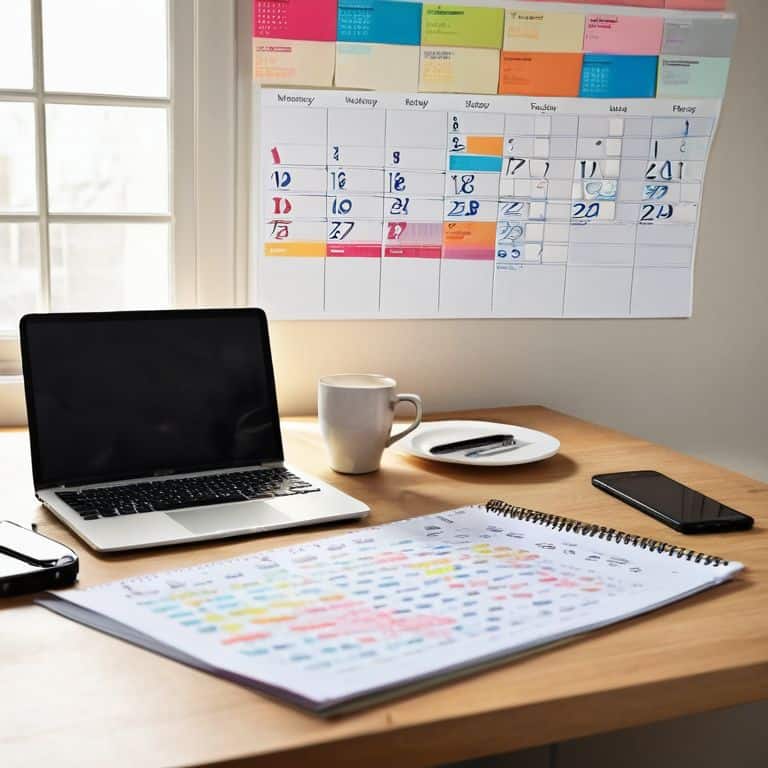I still remember the day I realized that my to-do list had become a source of stress rather than a tool for productivity. I was trying to juggle multiple tasks at once, and my calendar was a mess. That’s when I discovered the power of a guide to time blocking your calendar. It was like a breath of fresh air – suddenly, I had a clear plan and a sense of control over my schedule. I was able to prioritize my tasks, avoid procrastination, and achieve my goals with ease.
In this article, I’ll share my personal experience and expertise to help you create a step-by-step plan for time blocking your calendar. You’ll learn how to break down your tasks into manageable chunks, schedule them effectively, and make the most of your time. I’ll provide you with practical tips and tricks to help you overcome common obstacles and stay on track. By the end of this guide, you’ll have a clear understanding of how to use time blocking to boost your productivity and achieve your goals. Whether you’re a busy professional or a student, this guide will help you take control of your schedule and make the most of your time.
Table of Contents
- Guide Overview: What You'll Need
- Step-by-Step Instructions
- A Guide to Time Blocking Your Calendar
- Time Blocking Mastery: 5 Essential Tips to Supercharge Your Productivity
- Key Takeaways for Mastering Time Blocking
- Time Blocking Wisdom
- Putting it all Together: Mastering Time Blocking
- Frequently Asked Questions
Guide Overview: What You'll Need

Total Time: 1 hour 30 minutes
Estimated Cost: $0 – $10
Difficulty Level: Easy
Tools Required
- Computer or Mobile Device (with calendar app)
- Pen and Paper (for planning and note-taking)
Supplies & Materials
- Calendar or Planner (physical or digital)
- Colored Pens or Highlighters (for color-coding and organization)
Step-by-Step Instructions
- 1. First, let’s start by understanding what time blocking is and how it can benefit your daily schedule. Time blocking is a technique where you divide your day into smaller, manageable blocks of time, and assign each block a specific task or activity. This helps you prioritize your tasks, avoid multitasking, and minimize distractions.
- 2. Next, you’ll need to identify your goals and priorities for the day, week, or month. Take some time to reflect on what needs to be accomplished, and make a list of your tasks and activities. Be sure to include both personal and professional tasks, as well as any breaks or self-care activities you want to make time for.
- 3. Now, let’s talk about how to actually create a time block schedule. Start by opening your calendar, whether it’s a physical planner or a digital app, and begin blocking out time for each of your tasks and activities. Be sure to include buffer time between each block to account for transitions and unexpected interruptions.
- 4. When creating your time blocks, it’s essential to prioritize your tasks based on their importance and urgency. Use the Eisenhower Matrix to categorize your tasks into four quadrants: urgent and important, important but not urgent, urgent but not important, and not urgent or important. This will help you focus on the most critical tasks first and make the most of your time.
- 5. Once you have your time blocks scheduled, it’s crucial to minimize distractions and stay focused on the task at hand. Consider implementing a Pomodoro timer to work in focused 25-minute increments, followed by a 5-minute break. This technique can help you stay on track and avoid burnout.
- 6. As you start using your time block schedule, it’s essential to review and adjust regularly. Take time each week to reflect on what’s working and what’s not, and make adjustments as needed. This will help you identify areas for improvement and ensure that your schedule is aligned with your goals and priorities.
- 7. Finally, don’t forget to leave space for flexibility in your schedule. Life is unpredictable, and unexpected things will come up. By leaving some buffer time in your schedule, you can accommodate unexpected tasks or interruptions without derailing your entire day. Remember, the key to successful time blocking is to be consistent, yet flexible.
A Guide to Time Blocking Your Calendar

As you start implementing time blocking into your daily routine, it’s essential to consider calendar organization tips that will help you maximize your productivity. One of the most critical aspects of effective time blocking is prioritizing tasks based on their importance and deadlines. By doing so, you’ll be able to focus on the most critical tasks during your most productive hours, ensuring that you’re making the most out of your time.
To take your time blocking to the next level, consider integrating deep work into your schedule. This involves dedicating specific blocks of time to focus on a single, high-priority task without any distractions. By doing so, you’ll be able to complete tasks more efficiently and effectively, leading to increased productivity. Additionally, make sure to leave some buffer time between each task to avoid scheduling conflicts and allow for a smooth transition between activities.
When customizing your calendar for focus, remember to be flexible and adapt to changing circumstances. Avoiding scheduling conflicts is crucial to maintaining a stress-free and productive work environment. By following these tips and customizing your calendar for focus, you’ll be well on your way to achieving your goals and making the most out of your time.
Customizing Your Calendar for Focus
To customize your calendar for focus, start by identifying your most productive hours. Are you a morning person or do you thrive in the afternoons? Schedule your most critical tasks during these times. Next, consider your energy levels and attention span. Break down larger tasks into smaller, manageable chunks, and allocate specific time slots for each. This will help you avoid burnout and maintain a consistent workflow.
By tailoring your calendar to your unique productivity rhythm, you’ll be able to tackle tasks with greater efficiency and clarity. Remember to also leave some buffer time for unexpected tasks or self-care activities, ensuring a healthy work-life balance. With a customized calendar, you’ll be well on your way to achieving your goals and making the most of your time.
Prioritizing Tasks With Time Blocking
To get the most out of time blocking, it’s essential to prioritize your tasks effectively. Start by identifying your top goals and breaking them down into smaller, manageable chunks. Then, assign a level of importance and urgency to each task. Use the Eisenhower Matrix to categorize tasks into four quadrants: urgent & important, important but not urgent, urgent but not important, and not urgent or important. This will help you focus on the most critical tasks first and allocate your time accordingly.
By prioritizing your tasks in this way, you’ll be able to schedule your time blocks more efficiently, ensuring that you’re making progress on your most important goals. Remember to review and adjust your task list regularly to reflect changing priorities and deadlines. This will help you stay on track and make the most out of your time blocking schedule.
Time Blocking Mastery: 5 Essential Tips to Supercharge Your Productivity
- Set clear goals and priorities before blocking your time to ensure alignment with your objectives
- Start small by dedicating a limited block of time to focus on a single task, then gradually increase the duration as you build discipline
- Eliminate distractions during your time blocks by turning off notifications, logging out of social media, and finding a quiet workspace
- Schedule breaks and self-care activities to maintain energy and motivation throughout the day
- Review and adjust your time blocking schedule regularly to reflect changes in your priorities, tasks, and personal rhythms
Key Takeaways for Mastering Time Blocking
Implement a scheduling system where you allocate fixed, uninterrupted time slots for tasks, allowing you to prioritize and manage your workload more efficiently
Customize your calendar to reflect your unique productivity needs, including dedicated blocks for focus work, meetings, and self-care, ensuring a balance between work and personal life
Regularly review and adjust your time blocking schedule to accommodate changing priorities, new tasks, and lessons learned, treating it as a dynamic tool for continuous productivity improvement
Time Blocking Wisdom
A calendar without time blocking is like a map without a destination – it’s just a piece of paper, but with a clear plan, you can turn your daily schedule into a powerful tool for achieving your dreams.
Rachel Evans
Putting it all Together: Mastering Time Blocking

As we’ve journeyed through this guide to time blocking your calendar, we’ve covered the essential steps to transform your schedule from chaotic to streamlined. We started with the basics of what time blocking is and why it’s a game-changer for productivity. Then, we dived into the nitty-gritty of prioritizing tasks, customizing your calendar, and making the most out of each time block. By now, you should have a clear understanding of how to implement time blocking in your daily life, whether you’re a student, entrepreneur, or simply looking to manage your time more efficiently.
As you embark on this time blocking journey, remember that the key to success lies in consistency and flexibility. Don’t be too hard on yourself if you slip up – simply acknowledge the setback and get back on track. With time blocking, you’re not just managing your time; you’re investing in yourself. You’re creating space for what truly matters, whether that’s launching a new project, nurturing relationships, or simply enjoying some well-deserved downtime. So, take a deep breath, open your calendar, and start blocking your way to a more productive, fulfilling life.
Frequently Asked Questions
How do I handle unexpected tasks or interruptions when I've already time-blocked my calendar?
Don’t worry, life happens! When unexpected tasks pop up, I use a ‘buffer block’ – a 30-minute slot in my calendar for flexibility. If an interruption is unavoidable, I pause my current task and schedule it back in as soon as possible, ensuring I stay on track with minimal disruption.
Can I use time blocking for personal activities and habits, or is it only for work-related tasks?
Absolutely, time blocking isn’t just for work. I use it to schedule personal activities like exercise, meal prep, and even dedicated time for learning a new language. By blocking time for self-care and hobbies, you can ensure they don’t get lost in the shuffle, making it easier to maintain a healthy work-life balance.
What's the best way to review and adjust my time-blocking schedule to ensure it's still working effectively for me over time?
To review and adjust your time-blocking schedule, set a recurring monthly check-in on your calendar. Ask yourself: Are my priorities still aligned with my schedule? Are there any time-wasting patterns? Make adjustments as needed, and don’t be afraid to pivot – it’s all about finding a rhythm that works for you.














